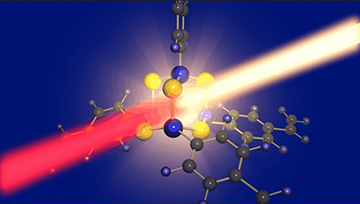Material devised by research team at Philipps-Universität Marburg, Germany, emits highly directional white light, with color temperature near that of tungsten-halogen sources, when excited by continuous-wave light from a low-cost NIR laser diode. [Image: Nils W. Rosemann] [View animation (GIF)]
German researchers have designed an amorphous material that can convert light from a cheap, continuous-wave infrared laser diode into highly directional white light similar in color to conventional tungsten-halogen incandescent light sources (Science, doi: 10.1126/science.aaf6138). The scientists believe that the material could excel as a low-cost light source in directional, high-brilliance applications such as projection and microscopy.
Searching for direction
While light-emitting diodes (LEDs) have offered a revolutionary source of low-cost, high-efficiency lighting, their emission tends to be Lambertian, with essentially isotropic luminance. That means that, although they excel in applications such as basic illumination and active displays with large viewing angles, they don’t fit as well in applications (such as microscopy) requiring a high spatial resolution, or as highly directional light sources, as in projection. Nonlinear supercontinuum sources, driven by pulsed lasers, can provide brilliant, point-source emissions of directed broadband light, but their size and high power requirements have tended to limit them to specialty applications.
The German team, led by Stefanie Dehnen and OSA Member Sangam Chatterjee of Philipps-
Universität Marburg, set themselves the task of designing—with inexpensive, readily available materials—a nonlinear medium that could convert laser light from a cheap, low-power infrared diode into reliable, directed white light. They began with an inorganic semiconducting tin-sulfide core, with the molecules arranged in a tetrahedral, “diamondoid” scaffold. The core unit cells were then decorated with organic ligands, tied to the tetrahedral vertices at random orientations, to provide a source of delocalized electrons.
Warm white light, low input power
The result is an amorphous white powder that’s stable in air to a temperature of 573 K. The team found that, when illuminated by a beam from an 800-nm continuous-wave diode laser, the material emitted a warm white light with a color temperature similar to the 2856 K value of tungsten-halogen light sources—and the color was tunable depending on the levels of laser excitation. Moreover, the light emitted from the nonlinear material retained the highly directional characteristics of the laser source, with a very narrow angular spread.
The team’s modeling suggests that the mechanism for white-light generation lies in excitation of the delocalized electrons in the organic ligands by the near-infrared laser light, and re-emission during accelerated motion of the electrons in an anharmonic potential field. The process, the team writes, is “conceptually similar to high-harmonic generation” in other systems—but with the advantage that only the electronic ground state is involved. That means that even a low-power, continuous-wave laser can kick off broadband emission with comparatively low required electric-field strengths.
The research team believes that the process it’s outlined—which combines a low-cost material and a cheap, low-power source of excitation—could offer new approaches for advanced, high-brightness directed-illumination and projection applications, and thus fill a niche complementary to the one occupied by LED sources.


